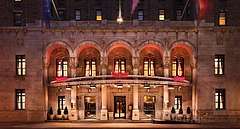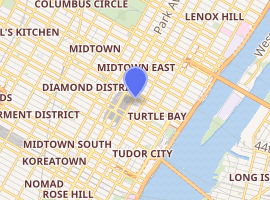New York Marriott East Side
The New York Marriott East Side is a hotel at 525 Lexington Avenue in Midtown Manhattan. It was built and opened in 1924 as the Shelton Towers Hotel.
| New York Marriott East Side | |
|---|---|
 Entrance of New York Marriott East Side | |

| |
| Former names | Shelton Towers Hotel Halloran House |
| Hotel chain | Marriott Hotels & Resorts |
| General information | |
| Architectural style | Romanesque Revival, other |
| Address | 525 Lexington Avenue |
| Town or city | Manhattan, New York |
| Coordinates | 40°45′20.2″N 73°58′21.4″W |
| Construction started | 1922 |
| Completed | 1923 |
| Opened | January 1924 |
| Height | 387 ft (118 m) |
| Technical details | |
| Floor count | 35 |
| Design and construction | |
| Architect | Arthur Loomis Harmon |
| Developer | James T. Lee |
| Awards and prizes | Gold Medal of Honor, Architectural League of New York (1925) Gold Medal, New York Chapter of the American Institute of Architects (1925) |
| Other information | |
| Number of rooms | 655 |
History
Construction for the Shelton Towers Hotel ran from 1922–1923,[1] and the building opened in January 1924.[2] The building was designed by Arthur Loomis Harmon, and the developer was James T. Lee, grandfather of Jacqueline Kennedy Onassis.[1] It was originally only open to men. However, it opened to women later in 1924.[1][2] When it opened, the hotel featured numerous "club" amenities, such as a gymnasium, a bowling alley, a Turkish bath, a swimming pool, a barber, squash courts, and billiard tables.[2]
In autumn 1925, artists Alfred Stieglitz and Georgia O'Keeffe moved into a two-room apartment on the 28th floor, and later moved to the 30th floor. O'Keeffe painted several works of the Shelton, or of the view from her room.[3]
In 1926, famed escape artist Harry Houdini performed an escape from an airtight case at the bottom of the hotel pool.[4]
The hotel was closed to the public in 1971 and was occupied only by a small number of long-term residents while developers considered proposals for renovation or even demolition.[4] It reopened in 1979 as Halloran House after renovations funded by developer Edward Halloran.[5]
Marriott Hotels & Resorts took over as operator in 1990.[4]
Controversial American-Israeli rabbi Meir Kahane was assassinated in the hotel's second-floor conference room on November 5, 1990.[6]
Morgan Stanley acquired the building in 2005 for $287 million.[7] The building underwent significant interior renovations in 2007 and exterior refurbishments in 2009.[4] Morgan Stanley sold the building in 2015 to Ashkenazy Acquisition and Deka Immobilien for $270 million.[7]
Architecture
The hotel stands 387 feet (118 m) tall, standing on a 24,000 sq ft (2,200 m2) plot between East 48th and East 49th Street. The first two stories are clad in Indiana limestone,[2] and the rest of the building is clad in brick.
According to the New York City Landmark Preservation Commission, the building's architectural style is Romanesque Revival.[1] However, architectural critics have noted an eclectic mix of styles:
The architect, Arthur Loomis Harmon, covered the mass with irregular yellowy-tan brick, roughened as if centuries old, and for details, drew from Romanesque, Byzantine, early Christian, Lombard and other styles. But critics were more impressed that it recalled 'no definite architectural style of the past,' as the artist Hugh Ferriss put it in The Christian Science Monitor in 1923.[4]
The building has several major setbacks, which were necessary to comply with New York City's 1916 Zoning Resolution. It was one of the first New York hotels to be built in this way.[4]
References
- "SHELTON HOTEL (LATER HALLORAN HOUSE)" (PDF). NYC Landmarks Preservation Commission. May 10, 2016. Retrieved 1 January 2018.
- Hoak, Edward Warren; Church, Willis Humphrey (2013). Masterpieces of American Architecture. Courier Corporation. p. N/A. ISBN 978-0-486-14727-7. Retrieved 1 January 2018.
- Benke, Britta (2000). Georgia O'Keeffe, 1887–1986: Flowers in the Desert. Taschen. p. 40. ISBN 978-3-8228-5861-5. Retrieved 1 January 2018.
- Gray, Christopher (26 March 2009). "Mr. Houdini, Your Box Is Ready". The New York Times. Retrieved 1 January 2018.
- "Design Notebook". The New York Times. 25 October 1979. Retrieved 1 January 2018.
- McCallister, Jared; Kates, Brian (6 November 1990). "Rabbi Meir Kahane is shot and killed after speech in 1990". NY Daily News. Retrieved 1 January 2018.
- "Ashkenazy, Deka put Marriott East Side on the market". The Real Deal New York. 30 September 2016. Retrieved 1 January 2018.